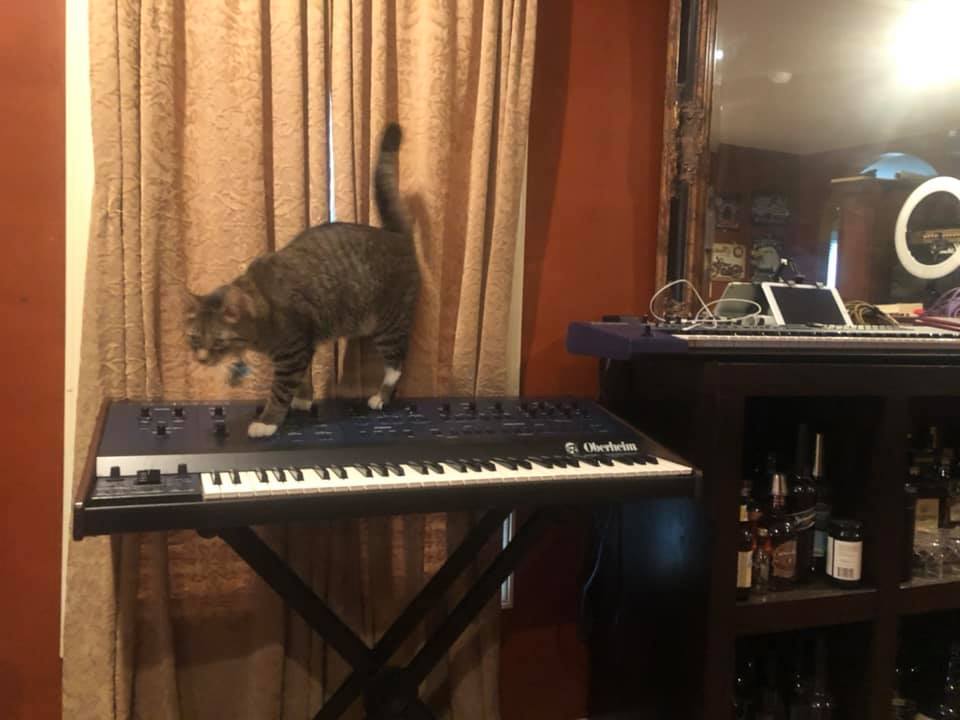
A tabby cat proudly walks across a vintage Oberheim OB-Xa, perhaps to try out their latest patch. From Michael Butler via Facebook.
If you have not yet done so, please check out our recent video on Arturia’s new OB-Xa V.

Dexter A. Catt of Circuit3 three is out with a new composition on the Sequential OB6. From Peter Fitzpatrick via our Facebook page.
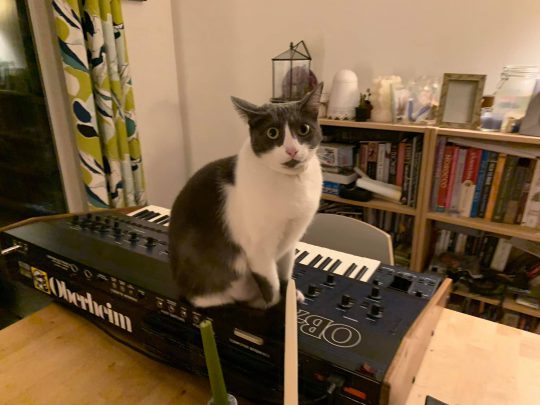
Gracie is back and performing her duties as the quality manager for Synthetic Dreamscapes.
This Oberheim OB-Xa is not totally rebuilt yet, but our Quality Manager just had to get in on the action early!
The OB-Xa is one of the classic Oberheim analog synths and was featured in lots of early 1980s synth-heavy pop music. For me personally, it would probably be more interesting to have the SEM filter to complement the other instruments, but it still has a sound that would be instantly familiar to fans of this era.
The OB-Xa is a massive analog synthesizer with a very familiar and classic Oberheim sound. Its sound, size and power are very similar to the Prophet 5 from Sequential. However this one has up to 8 voices which can be split, layered and stored!
The OB-X was very similar to the OB-Xa except that its voices could not be split or layered and, more significantly, the OB-X had a lowpass-only discrete SEM 12dB/oct state variable filter, which had a great and classic Oberheim sound. The OB-Xa changed that in an attempt to economize manufacturing and increase stability by switching to CEM3320 Curtis chips for its filters. The Xa offered two switchable filter modes: 12 dB/oct (2-pole) or 24 dB/oct (4-pole). This hardware change resulted in a more agressive sound, not quite as creamy as the OBX original, but what still became a “bread and butter” sound of the Oberheim line.
Vintage Synth Explorer: http://www.vintagesynth.com/oberheim/obxa.php
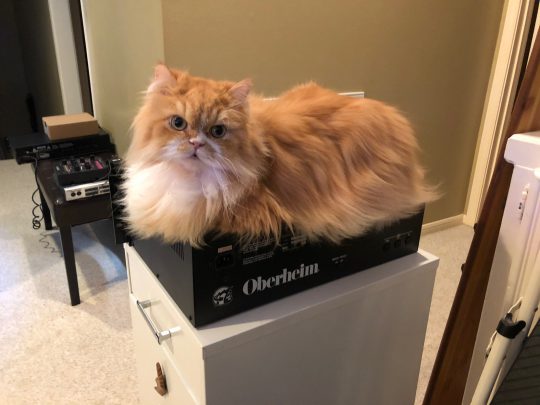
Yogi found a nice place to sit atop an Oberheim Matrix 6R rack-mount synth module. By Sayer Seely via Facebook.
The 6R is the rack-mount module version of the classic Oberheim Matrix 6 from the 1980s.
The Matrix 6 was one of the last few synthesizers from Oberheim to come out during the mid-eighties following the classic OB-series. The Matrix 6 utilized high-tech but less expensive digital and midi features and still retained a totally analog sound. It did this by using DCOs (digitally controlled oscillators) to provide stability, programmability and more. All the Matrix synthesizers featured Matrix Modulation which allows for extremely wild virtual patching for almost unlimited range of sounds and modulation capabilities!
http://www.vintagesynth.com/oberheim/mat6.php
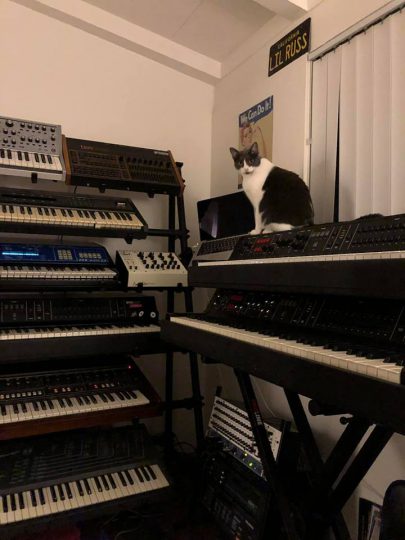
Grace returns to CatSynth, this time presiding as queen atop a rather impressive collection of vintage synths. We see Moog, Oberheim, PPG, Synergy, and more!
From our friend Alsún Ní Chasaide (Alilson Cassidy) on Facebook.
You see Grace’s other posts here.
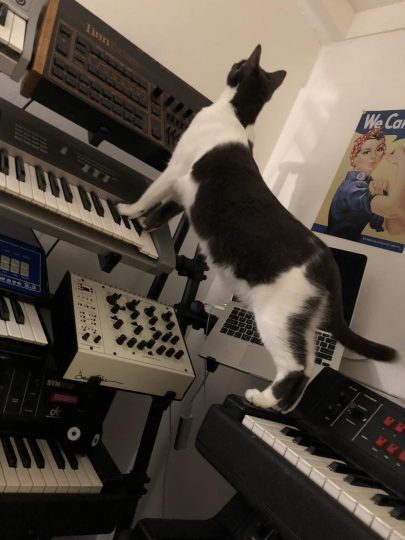
Gracie returns with an impressive collection of vintage synths, including multiple Oberheim modules, a PPG Wave, and a Synergy.
From Alsún Ní Chasaide (Alison Cassidy) on Facebook.
How does she even get up there??
You can see Gracie’s many appearances on CatSynth via this link.
It’s been a little while since we last attended Church of Thee Super Serge at Robotspeak in San Francisco, but we made a point of going this past weekend. For those who have not been there or read our past reviews, it’s an almost-ever-month show on a Saturday afternoon with live hardware-synthesizer performances. As the name suggests, some acts do include Serge synthesizers, but it is not required, and a wide variety of instruments are used. All three sets are featured in our most recent CatSynth TV episode.
The first set featured Lx Rudis performing on an Oberheim Xpander, a somewhat underappreciated instrument from the 1980s.
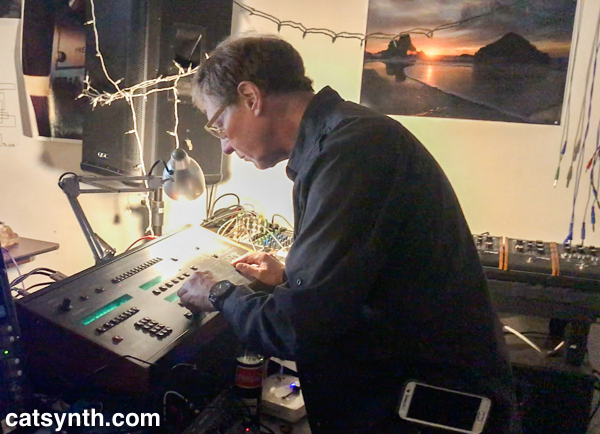
At its heart, the Xpander is a 6 voice analog synthesizer, but with a complex array of digital controls that can be programmed and applied independently to each voice. Lx Rudis took full advantage of these, especially the LFOs and lag generators, to create subtle and minimal metric patterns. He constantly moved voices in and out, configuring them on the fly, in a way that was very expressive and musical. I particularly liked the sections which had staccato rhythmic textures against slowly moving timbres deliberately out of sync with one another.
Next up was Franck Martin, who performed a solo set on a modular synthesizer with several standalone instruments.
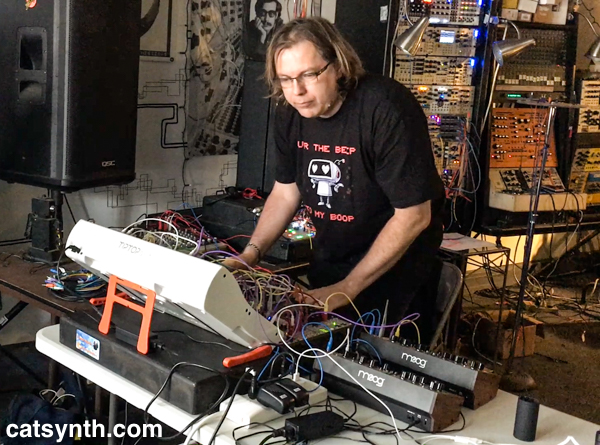
Martin’s setup included a Moog Subharmonicon, which he built while attending Moogfest this year (we at CatSynth are a bit envious), as well as a DFAM (Drummer From Another Mother). There were also additional voices provided by Braids and Plaits modules from Mutable Instruments that he could bring in and out using a touch-plate interface. The result was a slowly changing beat pattern with an eerie inharmonic voicing and gentle undulation.
The final set featured our friends Gino Robair and Tom Djll teaming up as the brilliantly named Unpopular Electronics.
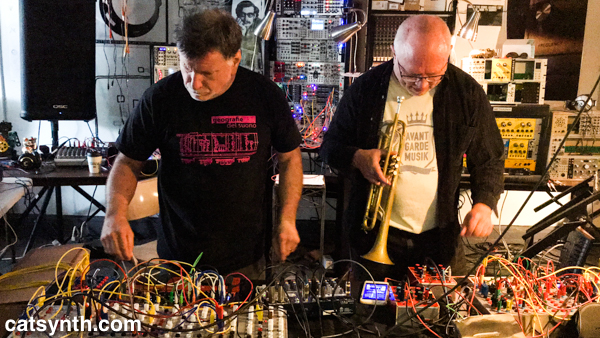
They had a wide variety of gear, including Serge panels in addition to Eurorack modules and standalone instruments from Bugbrand and others. In addition, Gino had an interesting small case that included touchpads.
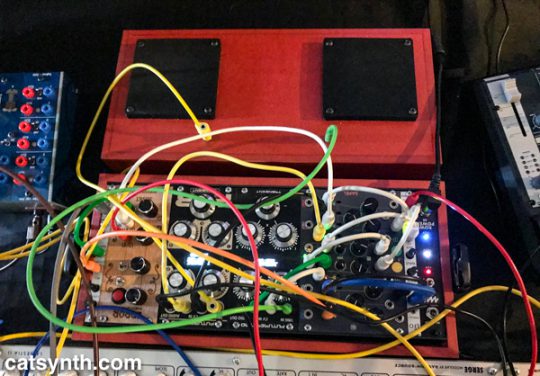
The music was frenetic and intense, an avalanche of pops and hits and loud cloudlike tone clusters. And there were trumpet sounds entering into the mix at various points. But there was an exquisite detail to the madness with changes among the different instruments and sounds, and musical pauses and rests before the pair dived back into the frenzy. There were also many moments of humor and not just Djll’s book about why there aren’t any Zeppelin-style airships in the United States.
In between sets, it’s fun to browse around Robotspeak and see what’s for sale, or on display in the big glass case.
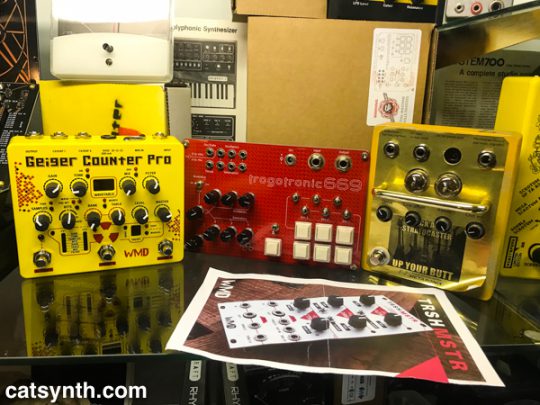
It’s also quite dangerous, as I am often tempted to leave with another module or instrument. On this occasion, I exercised restraint, but probably not next time…
A new video from our friends Charles Whiley and Mr. Maximillion.
“Look Out Noise”
🎼
🎶
🎚
🎛
🎚
🎛
🔊
🎧
🎹
💖
🤩
😼
🔊
🔊
🔊
💖
😻
😺
We espy quite a few of the usual suspects, including their Novation Peak, JoMoX Alpha Base, Source Audio Nemesis, and Oberheim Matrix 1000. This time I also notice a JoMoX Moonwind, a T.C. Electronics rackmount effects box, and more. What gear did you notice in the video?
A new video from our friends Mr. Maximillion and Charles Whiley, featuring a beat-based jam with sundry synthesizers.
Between the fast pans and cute shots of our feline friend, we at CatSynth were able to identify the following instruments:
What other synths can you find in the video? 😺